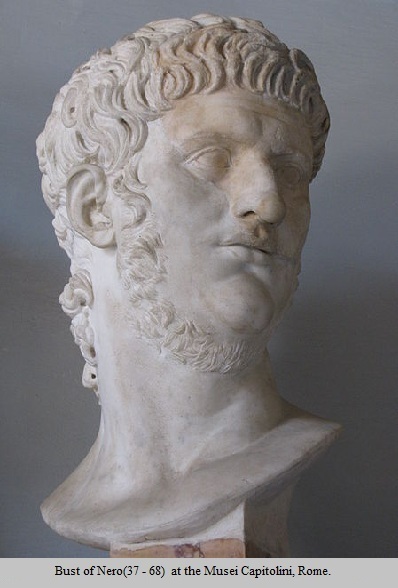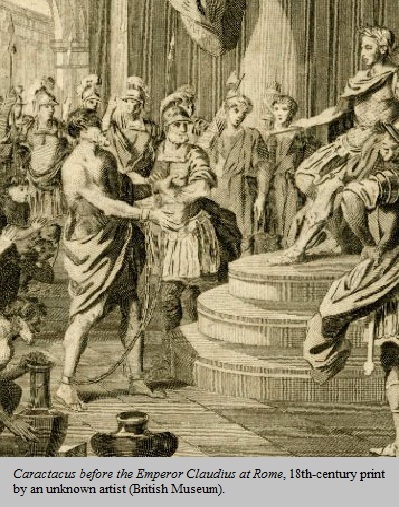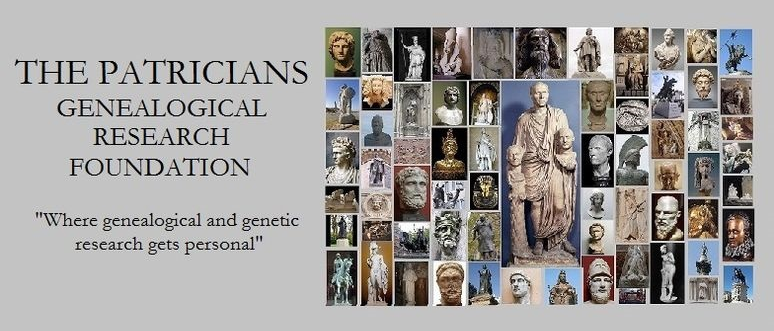













The Welsh word for “lion” is spelled l-l-e-w. An anglicized spelling would be l-l-e-y-n. A latinized spelling would be l-i-n-u-s.
Englishman Linus was the third great-grandson of Saint Joseph of Arimathea, Jesus of Nazareth‘s uncle, whose daughter Anna married Lludd ap Beli..
His father was Caratacus, King of Britons ( – 54). He was the son of Bran Fendigaid “The Blessed” of Siluria who was the first King of Britons to convert to Christianity. His mother, Enygeus of Arimathea, was Saint Joseph’s sister.
During the early part of his reign, Caratacus attempted to expel the Romans from Briton. He was finally defeated and captured. He and his family were then transported to Rome for execution on the orders of Emperor Claudius (10 BC – 54). Before the sentence was carried out, Caratacus was brought before Claudius at his court to hear his official execution decree. In response, Caratacus gave a speech pleading for mercy that was so compelling and eloquent that Claudius immediately rescinded the decree. He later gave Caratacus one of his daughter’s hand in marriage.
Still in Roman captivity, Caratacus and his family resided at Palatium Brittanicum (Palace of Britons). Built on Esquiline Hill by his ancestors (members of which served as ambassadors to Rome after Julius Caesar‘s conquest of Briton), the compound was a place of worship for gentile Christians. After Caratacus was released from captivity and returned to Briton, it also served as a sanctuary.
The aforementioned paleo-Christian church, known today as the Basilica of Santa Pudenziana, is the oldest Catholic church in Rome. It was dedicated to Saint Pudenziana, the martyred daughter of Claudia. Claudia was the daughter of Caratacus; her husband Rufus Pudens was a Roman senator (along with Linus, both are mentioned by name in 2 Timothy 4:21.) Today, it is the Catholic national church of the Philippines.
Most scholars of the Catholic Church generally concede Linus, not Peter, was the first Bishop of Rome. Moreover, Irenaeus, the 2nd-century French bishop, and theologian wrote: “The blessed apostles, then, having founded and built up the Church, committed into the hands of Linus the office of the episcopate.” The Oxford Dictionary of Popes interprets this statement as meaning that Linus was the first Bishop of Rome, or Pope, as the title of the office became known during the 4th century. The Church may have later preferred naming Peter as the first Bishop of Rome for political reasons, most likely because he was one of the Twelve Apostles. Nevertheless, it’s interesting to note that the New Testament (see 2 Timothy 4:21) only cites Paul and Linus as Bishops of Rome.
Acting as the first Bishop of Rome for twelve years after the martyrdom of Saint Peter, he was invested with the ultimate responsibility for managing ecclesiastic affairs of the fledgling religion. Jesus and the Apostles may have been the guiding light of Christianity, but thereafter Linus was surely the first torch holder and defender of the faith. Thus, he may well be considered one of the initial founders, perhaps the first, of the Roman Catholic Church. Given the Roman persecution of the faith at the time, however, it wouldn’t have been an enviable position to behold.
In his The Passion of Peter and Paul. Linus chronicles the life and times of Apostles Peter and Paul. Without question, it is the first historical account of them both written by their intimate contemporary and religious associations. As such, the tract may well have formed the basis for certain books of The New Testament. Linus likely personally witnessed the martyrdom of both Peter and Paul.
Linus takes credit for the modern convention of christening children with given names during baptism. Before his papal bull in that regard, given names were adopted only after a child reached adulthood. A forename then usually described some unique characteristic the individual possessed as a child. We see the old convention lingered on through the Middle Ages in the naming of kings, for example, as “The Great” or “The Good”, etc.
His name remains in the text of the First Intercession Prayer said in the Canon of the Roman Mass. The following is the Latin text of the prayer, followed by the English translation:
“Communicantes, et memoriam venerantes, in primis gloriosae semper Virginis Mariae, Genetricis Dei et Domini nostri Iesu Christi: sed et beati Ioseph, eiusdem Virginis Sponsi, et beatorum Apostolorum ac Martyrum tuorum, Petri et Pauli, Andreae, (Iacobi, Ioannis, Thomae, Iacobi, Philippi, Bartholomaei, Matthaei, Simonis et Thaddaei: Lini, Cleti, Clementis, Xysti, Cornelii, Cypriani, Laurentii, Chrysogoni, Ioannis et Pauli, Cosmae et Damiani) et omnium Sanctorum tuorum; quorum meritis precibusque concedas, ut in omnibus protectionis tuae muniamur auxilio. (Per Christum Dominum nostrum. Amen.)”
(In communion with those whose memory we venerate, especially the glorious ever-Virgin Mary, Mother of our God and Lord, Jesus Christ, and blessed Joseph, her Spouse, your blessed Apostles and Martyrs, Peter and Paul, Andrew, (James, John, Thomas, James, Philip, Bartholomew, Matthew, Simon, and Jude: Linus, Cletus, Clement, Sixtus, Cornelius, Cyprian, Lawrence, Chrysogonus, John and Paul, Cosmas and Damian) and all your Saints; we ask that through their merits and prayers, in all things we may be defended by your protecting help. [Through Christ our Lord. Amen.])
Roman Martyrology, the official Catholic Church registry of recognized martyrs, doesn’t list Linus. Some of his anti-papist detractors today, however, will tell you that he was the first anti-Christ (or anti-Pope). According to them, Paul ordered Linus to burn Rome to the ground as retribution for Emperor Nero‘s brutal murder of Jesus’ brother, James the Just. Nero discovered the plot but not before a quarter of a million Romans perished in the conflagration Linus ordered set. Nero, who’s seen as a hero by this group, managed to extinguish the blaze before any more Romans were burned to death.
Nero, a grand nephew of Claudius I, didn’t fiddle around in summarily executing Linus at Circus Maximus after his capture. He was undoubtedly deemed a martyr by his followers almost instantly. The Catholic Church, however, deemed his act of arson rendered him less than worthy of beatification as a martyr.
Linus’ feast is celebrated on 23 September.
After 920 years, the first Pope of Saxon (or northern European/Scandinavian) ethnicity was elected to the Papacy. Born in Germany, Pope Gregory V, the 138th Pope, was Pope from 3 May 996 until he died in 999.
Lleyn ap Caratacus, St Linus
Birth in Siluria
Death in Roma, Lazio, Italy
Ancestry.com citation/Lineages
59th great grand uncle COELING-DESPOSYNI-MEROVING-SCHELDE-ALSACE-PLANTAGENET-HOWARD-WOOD-COLLINS
59th great grand uncle COELING-VERE-WARREN-HOLLAND-SIMMONS-COLLINS
65th great grand uncle MEROVING-CAROLMAN-FLANDERS-CAMBRAI-REMI-LENS-DEMAREST-TERHUNE-BANTA-BRINKERHOFF-OUTWATER-COLLINS
1st cousin 61x removed COELING-COELING-WESSEX-MERCIA-HOWARD-WOOD-COLLINS
1st cousin 59x removed COELING-ASGARD-NEILL-MACALPIN-LEROY-MAULAY-LA POINTE-MOREAU-GIROUX-MERON-BRULE
1st cousin 69x removed COELING-YNGLING-D’AVRANCHES-EGERTON-WILBRAHAM-DOANE-MARSHALL-POTTER-TRIPP-OUTWATER-COLLINS
1st cousin 61x removed COELING-ASGARD-WESSEX-MERCIA-HOWARD-WOOD
4th cousin 60x removed EWYAS-BRETAGNE-CORNOUAILLE-PORHOET-ROHAN-LANDRY-BOURG-CYR-BRULE
1st cousin 61x removed COELING-STRATHCLYDE-VERE-WARREN-HOLLAND-SIMMONS-COLLINS
1st cousin 61x removed COELING-DESPOSYNI-MEROVING-CAROLMAN-FLANDERS-CAMBRAI-REMI-LENS-DEMAREST-TERHUNE-BANTA-BRINKERHOFF-OUTWATER-COLLINS
SOURCES
FAB PEDIGREE: Catholic Popes
St Peter’s Cathedral Tombs Wiki
Pope Linus
Relation to the First Bishop of Rome, Lleyn ap Caradog (St. Linus), Thoughts on Science, History, Poetry and Politics, Dr. Myron Evans
Santa Pudenziana Wiki
St, Paul in Rome: 5. Concluding Observations
Israelology – The Birthright, House of Israel, Kingdom, and Sons of God
Venissa Wiki
Claudius Wiki
Caratacus Wiki
When Did the Apostle Peter Meet His Death? article
Did the Apostle Peter EVER Visit Rome? article
Brief History of Christianity by Hyrum Smith
ONE-EVIL.org: Pope Linus
Caractacus: Wikispeedia
The Catholic Defender: St. Linus, The First Successor Of St. Peter
Linus: Author of The Passion of Saint Paul, The Acts of Linus (Acta Petri et Pauli gnostica)
1
2
3
4
A compleat history of the canon and writers of the books of the Old and New Testament (London, 1699)
BIBLIOGRAPHY
The Drama of the Lost Disciples
Seventy Disciples: Pope Linus, Saint Stephen, Mark the Evangelist, Saint Timothy, Barnabas, Luke the Evangelist, Titus, Apollos, Saint Ma
1st-century Christian Saints including Titus biblical Apollos John The Baptist John The Evangelist Pope Linus Saint Timothy John The Apostle Pope Anacletus Sosthenes Abgar V Of Edessa Pontius Pilate Silas Saint Longinus Saint Dismas
Anglo-Israel Or the British Nation the Lost Tribes of Israel
Israel’s Wanderings or the Sciiths the Saxons and the Kymry A Connected Account Tracing the Lost Tribes of Israel Into the British Isles
Rome Against Caratacus: The Roman Campaigns in Britain AD 48-58
The Blood of Avalon: The Secret History of the Grail Dynasty from King Arthur to Prince William
Caractacus and Claudius
Caractacus. A dramatic poem
Italian Roman Catholic Saints: Pope Linus, Augustine of Canterbury, Pope Gregory III, Pope Telesphorus, Pope Victor I, Pope Zachary
The Patricians, A Genealogical Study – Ebook Editions (Epub, PDF & Kindle) US$5.95


Steven Wood Collins (1952 – ) Antiquarian, Genealogist, Novelist


3 replies on “St Linus, Lleyn ap Caratacus ( – 76) 1st Bishop of Rome, 1st Anti-Pope, Founder of the Roman Catholic Church”
[…] St Linus, Lleyn ap Caratacus ( – 76) Founder of the Roman Catholic Church 2GGU […]
LikeLike
[…] St Linus, Lleyn ap Caratacus ( – 76) Founder of the Roman Catholic Church h […]
LikeLike
[…] St Linus, Lleyn ap Caratacus ( – 76) Founder of the Roman Catholic Church 2GGU agnatic […]
LikeLike